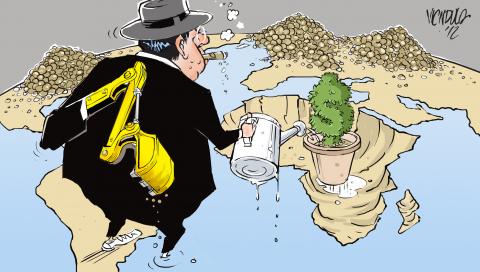
Ecological civilization is characterized by the need to repair the contradictory relationship between human and nature, and human and the environment. The phenomenon of the concentration of fertility from one place to the city, turning it into garbage, is the material basis of the contemporary urban-rural conflict.
Over the past two hundred years, in response to this problem, everyone from Liebig to Borlaug has advocated the cultivation of artificial fertilizers to supplement soil fertility. In the 19th century, before the advent of the organic chemical industry, the so-called fertilizers were bird droppings.
In order to dig up guano, many Chinese laborers were shipped to the region as workers, and the basis of the agricultural revolution in Europe and America at that time was these cheap Chinese laborers. After entering the 20th century, compound fertilizer was widely used in agricultural production through different ratios of various elements such as nitrogen, phosphorus, and potassium. However, this did not solve the problem at its root, but made agriculture more and more dependent on fossil fuels and compound fertilizers.
The various ways of fertilizing the soil are often a central part of the so-called “Green Revolution,” but this is not the greening of “green ecology.” Instead, it is mainly to distinguish it from the “Red Revolution.” Before liberation, the Rockefeller Foundation had conducted scientific experiments in Mexico and social experiments in China. The imperialists tried to explore new ways of governing the underdeveloped societies of the East but ultimately failed. The Chinese revolution drove the Rockefellers and their experiments out of China, and the Ford Foundation and other such organizations looked to India to take over the techno-social experiments of the past and create a new philosophy, the so-called “Green Revolution.” The Green Revolution was epitomized by Borlaug, who was awarded the Nobel Peace Prize, but not for science, which is self-explanatory.
Paul Hoffman, president of the Ford Foundation in the early days of the Cold War, was also a Marshall Plan executive. He once mentioned that If the U.S. had done the Green Revolution in China in 1945, it would have cost no more than $200 million a year. India was China in 1945 for him.
China’s ecological civilization construction in the past two to three decades has made brilliant and remarkable achievements. However, looking towards the future, this work has a long way to go, and how to do a better job of ecological civilization construction is a problem that China must solve at present and in the future.
The “Green Revolution” was not a simple technology but a political project with clear Cold War political connotations.
In terms of per capita cereal production in India, wheat yields rose rapidly after 1965, while yields of other important crops, such as rice and sorghum, increased slowly. The rate of growth of per capita cereal production in India did not show much change after this period. The so-called Green Revolution involved seeds, fertilizers, water projects, and other technological tools that did not truly improve and enhance the ability of Indians to feed themselves.
Worldwide, per capita cereal production was on an upward trend from the 1960s to the early 1980s, but it has stagnated since then. In the 2010s, per capita cereal production had not even surpassed the levels of the early 1980s. Thus, the potential of the Green Revolution has been exhausted, even in terms of overall world productivity.
North Korea invested heavily in the Green Revolution. As early as the Kim Il Sung period, North Korea proposed the electrification of agriculture, and its agricultural development achieved very good results, surpassing South Korea’s. However, this success was entirely dependent on the use of fertilizers and inputs.
From 1961 to 1991, fertilizer and cereal output in North Korea showed an upward trend. In the early 1990s, geopolitical changes led to a 90% reduction in North Korea’s fertilizer inputs, which caused a significant decline in grain output and triggered a period of food hardship known as the “March of Misery.” At that time, North Korea’s heavy industry was one of the best in Northeast Asia, but it paid a high price for its complete dependence on industrialized agriculture and has not yet emerged from this predicament completely.
How do South Korea and Japan perform compared to North Korea? Looking at the grain yields of several East Asian countries in 2020, the DPRK, with a fertilizer intensity of about 14 kg per hectare, produced 3,496 kg of grain, which is quite a good performance. Japan and South Korea’s fertilizer intensity exceeds North Korea’s by more than ten times, but their grain yields are only twice that of North Korea. In fact, Japan and South Korea rely heavily on chemical inputs combined with large grain imports to maintain their current situation. In contrast, North Korea’s ability to achieve its present level under difficult conditions is remarkable, reflecting its efforts to move away from chemical and industrialized agriculture within the constraints of industrial civilization.
The highly developed market economies in Europe and the United States rely on a high density of long-distance trade, embedded in local labor and the fertility of the land. African coffee and Latin American fruits are shipped to New York and Europe to become consumer goods, where their nutritional value is eventually transformed into local garbage.
In cities with developed market economies, these products often end up as waste. However, in traditional agricultural societies, substances such as human feces and urine are not considered garbage; they are invaluable resources. Without long-distance trade and frequent movement of materials across regions, these nutrients flow back to where they came from and continue to circulate. In this sense, a circular economy and ecology is a closed-loop system.
Source: Asiapress, Getty Images, Carton Movement



